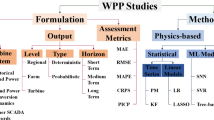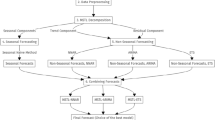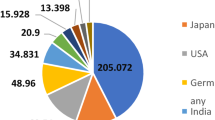Abstract
Accurate wind speed forecasting (WSF) has become increasingly important to overcome the adverse effects of stochastic nature of the wind on wind power generation. This paper proposes a multi-step hybrid online WSF model by combining online sequential extreme learning machine (OSELM), optimized variational mode decomposition (OVMD) and cuckoo search optimization algorithm (CSO). OVMD decomposes the wind speed series into subseries, and CSO selects the input features for each subseries. Multi-step forecasting for each subseries is performed using OSELM model optimized by CSO. Finally, the forecasting results are obtained by the aggregate calculations. The proposed model has been examined by using 10-min average wind speed data collected in monsoon and winter seasons from a supervisory control and data acquisition system of a 1.5 MW wind turbine situated in central dry zone of Karnataka, India. The results reveal that the model proposed captures the nonlinear characteristics of the wind speed in a better manner in comparison with the batch learning approach, giving accurate wind speed forecasts. This can help wind farms to estimate the wind power in a location efficiently.








Similar content being viewed by others
References
Azorin-Molina C, Guijarro JA, McVicar TR, Vicente-Serrano SM, Chen D, Jerez S, Espírito-Santo F (2016) Trends of daily peak wind gusts in Spain and Portugal, 1961–2014. J Geophys Res Atmos 121(3):1059–1078
Barbounis TG, Theocharis JB (2007) A locally recurrent fuzzy neural network with application to the wind speed prediction using spatial correlation. Neuro-computing 70(7–9):1525–1542
Basu M, Chowdhury A (2013) Cuckoo search algorithm for economic dispatch. Energy 60:99–108
Cadenas E, Rivera W (2010) Wind speed forecasting in three different regions of mexico, using a hybrid arima-ann model. Renew Energy 35(12):2732–2738
Cao W, Gao J, Ming Z, Cai S, Shan Z (2018) Fuzziness-based online sequential extreme learning machine for classification problems. Soft Comput 22(11):3487–3494
Chang GW, Lu HJ, Chang YR, Lee YD (2017) An improved neural network-based approach for short-term wind speed and power forecast. Renew Energy 105:301–311
Chen H, Wan Q, Li F, Wang Y (2013) Garch in mean type models for wind power forecasting. In: Power and energy society general meeting (PES). IEEE, pp 1–5
Dragomiretskiy K, Zosso D (2014) Variational mode decomposition. IEEE Trans Signal Process 62(3):531–544
Du P, Wang J, Guo Z, Yang W (2017) Research and application of a novel hybrid forecasting system based on multi-objective optimization for wind speed forecasting. Energy Convers Manag 150:90–107
Erdem E, Shi J (2011) Arma based approaches for forecasting the tuple of wind speed and direction. Appl Energy 88(4):1405–1414
Fan S, Liao JR, Yokoyama R, Chen L, Lee WJ (2009) Forecasting the wind generation using a two-stage network based on meteorological information. IEEE Trans Energy Convers 24(2):474–482
Ghobaei-Arani M, Rahmanian AA, Aslanpour MS, Dashti SE (2018) CSA-WSC: cuckoo search algorithm for web service composition in cloud environments. Soft Comput 22(24):8353–8378
Guo Z, Zhao J, Zhang W, Wang J (2011) A corrected hybrid approach for wind speed prediction in hexi corridor of china. Energy 36(3):1668–1679
Guo Z, Zhao W, Lu H, Wang J (2012) Multi-step forecasting for wind speed using a modified emd-based artificial neural network model. Renew Energy 37(1):241–249
Guo W, Wei H, Ong YS, Hervas JR, Zhao J, Wang H, Zhang K (2018) Numerical analysis near singularities in RBF networks. J Mach Learn Res 19(1):1–39
Huang GB, Zhu QY, Siew CK (2004) Extreme learning machine: a new learning scheme of feedforward neural networks. In: 2004 IEEE international joint conference on neural networks, 2004. Proceedings, vol 2, pp 985–990
Khare V, Nema S, Baredar P (2013) Status of solar wind renewable energy in India. Renew Sustain Energy Rev 27:1–10
Li G, Shi J (2010) Application of bayesian model averaging in modeling long term wind speed distributions. Renew Energy 35(6):1192–1202
Li G, Shi J, Zhou J (2011) Bayesian adaptive combination of short-term wind speed forecasts from neural network models. Renew Energy 36(1):352–359
Li Z, Ye L, Zhao Y, Song X, Teng J, Jin J (2015) Four wind speed multi-step forecasting models using extreme learning machines and signal decomposing algorithms. Energy Convers Manag 100:16–22
Li Z, Ye L, Zhao Y, Song X, Teng J, Jin J (2016) Short-term wind power prediction based on extreme learning machine with error correction. Prot Control Mod Power Syst 1(1):1
Liang NY, Huang GB, Saratchandran P, Sundararajan N (2006) A fast and accurate online sequential learning algorithm for feedforward networks. IEEE Trans Neural Netw 17(6):1411–1423
Liu H, Tian HQ, Chen C, Li YF (2010) A hybrid statistical method to predict wind speed and wind power. Renew Energy 35(8):1857–1861
Liu H, Chen C, Tian HQ, Li YF (2012a) A hybrid model for wind speed prediction using empirical mode decomposition and artificial neural networks. Renew Energy 48:545–556
Liu H, Tian HQ, Li YF (2012b) Comparison of two new arima-ann and arima kalman hybrid methods for wind speed prediction. Appl Energy 98:415–424
Liu H, Tian HQ, Pan DF, Li YF (2013) Forecasting models for wind speed using wavelet, wavelet packet, time series and artificial neural networks. Appl Energy 107:191–208
Liu D, Niu D, Wang H, Fan L (2014) Short-term wind speed forecasting using wavelet transform and support vector machines optimized by genetic algorithm. Renew Energy 62:592–597
Liu H, Tian H, Liang X, Li Y (2015a) New wind speed forecasting approaches using fast ensemble empirical model decomposition, genetic algorithm, mind evolutionary algorithm and artificial neural networks. Renew Energy 83:106–1075
Liu H, Tian HQ, Liang XF, Li YF (2015b) Wind speed forecasting approach using secondary decomposition algorithm and elman neural networks. Appl Energy 157:183–194
Mohandes MA, Halawani TO, Rehman S, Hussain AA (2004) Support vector machines for wind speed prediction. Renew Energy 29(6):939–947
Niu T, Wang J, Zhang K, Du P (2018) Multi-step-ahead wind speed forecasting based on optimal feature selection and a modified bat algorithm with them cognition strategy. Renew Energy 118:213–229
Peng X, Zheng W, Zhang D, Liu Y, Lu D, Lin L (2017) A novel probabilistic wind speed forecasting based on combination of the adaptive ensemble of on-line sequential orelm (outlier robust extreme learning machine) and tvmcf (time-varying mixture copula function). Energy Convers Manag 138:587–602
Rajabioun R (2011) Cuckoo optimization algorithm. Appl Soft Comput 11(8):5508–5518
Ren Y, Suganthan PN, Srikanth N (2015) A comparative study of empirical mode decomposition-based short-term wind speed forecasting methods. IEEE Trans Sustain Energy 6(1):236–244
Rodriguez H, Flores JJ, Morales LA, Lara C, Guerra A, Manjarrez G (2019) Forecasting from incomplete and chaotic wind speed data. Soft Comput 23(20):10119–10127
Salcedo-Sanz S, Pastor-Sánchez A, Prieto L, Blanco-Aguilera A, García-Herrera R (2014) Feature selection in wind speed prediction systems based on a hybrid coral reefs optimization extreme learning machine approach. Energy Convers Manag 87:10–18
Salcedo-Sanz S, Pastor-Sánchez A, Del Ser J, Prieto L, Geem ZW (2015) A coral reefs optimization algorithm with harmony search operators for accurate wind speed prediction. Renew Energy 75:93–101
Sánchez I (2008) Adaptive combination of forecasts with application to wind energy. Int J Forecast 24(4):679–693
Sheela KG, Deepa S (2014) N Performance analysis of modeling framework for prediction in wind farms employing artificial neural networks. Soft Comput 18(3):607–615
Shrimali G, Trivedi S, Srinivasan S, Goel S, Nelson D (2016) Cost-effective policies for reaching India’s 2022 renewable targets. Renew Energy 93:255–268
Tong JL, Zhao ZB, Zhang WY (2012) A new strategy for wind speed forecasting based on autoregression and wavelet transform. In: 2012 2nd international conference on remote sensing, environment and transportation engineering (RSETE). IEEE, pp 1–4
Wang J, Zhang W, Li Y, Wang J, Dang Z (2014) Forecasting wind speed using empirical mode decomposition and elman neural network. Appl Soft Comput 23:452–459
Wang J, Hu J, Ma K, Zhang Y (2015) A self-adaptive hybrid approach for wind speed forecasting. Renew Energy 78:374–385
Wang D, Luo H, Grunder O, Lin Y (2017) Multi-step ahead wind speed forecasting using an improved wavelet neural network combining variational mode decomposition and phase space reconstruction. Renew Energy 113:1345–1358
Xie L, Tao D, Wei H (2018) Early expression detection via online multi-instance learning with nonlinear extension. IEEE Trans Neural Netw Learn Syst 30(5):1486–1496
Zhang C, Wei H, Zhao J, Liu T, Zhu T, Zhang K (2016a) Short-term wind speed forecasting using empirical mode decomposition and feature selection. Renew Energy 96:727–737
Zhang C, Wei H, Xie L, Shen Y, Zhang K (2016b) Direct interval forecasting of wind speed using radial basis function neural networks in a multi-objective optimization framework. Neurocomputing 205:53–63
Zhang C, Wei H, Zhao X, Liu T, Zhang K (2016c) A Gaussian process regression based hybrid approach for short-term wind speed prediction. Energy Convers Manag 126:1084–1092
Zhang C, Zhou J, Li C, Fu W, Peng T (2017) A compound structure of elm based on feature selection and parameter optimization using hybrid backtracking search algorithm for wind speed forecasting. Energy Convers Manag 143:360–376
Zhao J, Wang J, Liu F (2015) Multistep forecasting for short-term wind speed using an optimized extreme learning machine network with decomposition based signal & #xC;filtering. J Energy Eng 142(3):04015036
Zhao X, Wei H, Wang H, Zhu T, Zhang K (2019) 3D-CNN-based feature extraction of ground-based cloud images for direct normal irradiance prediction. Sol Energy 181:510–518
Funding
This study is not funded by any institution or funding agency.
Author information
Authors and Affiliations
Corresponding author
Ethics declarations
Conflict of interest
The authors declare that they have no conflict of interest.
Human and animals rights
No human subjects or animals were used during this work, as the research work is purely theoretical based on mathematical modeling and requires only the use of laptop/PC.
Informed consent
The first author is a Ph.D. scholar and this manuscript is a result of this Ph.D. research work and her contribution is 80%. The second author is her guide and the third author is her co-guide and their contribution is in guiding her thesis/research work and is 10% each.
Additional information
Communicated by V. Loia.
Publisher's Note
Springer Nature remains neutral with regard to jurisdictional claims in published maps and institutional affiliations.
Rights and permissions
About this article
Cite this article
Shetty, R.P., Sathyabhama, A. & Pai, P.S. An efficient online sequential extreme learning machine model based on feature selection and parameter optimization using cuckoo search algorithm for multi-step wind speed forecasting. Soft Comput 25, 1277–1295 (2021). https://doi.org/10.1007/s00500-020-05222-x
Published:
Issue Date:
DOI: https://doi.org/10.1007/s00500-020-05222-x




